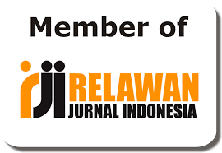Student’s mathematical literacy in solving PISA model problems based on the reflective-impulsive cognitive style
Literasi matematik siswa dalam menyelesaikan soal model PISA ditinjau dari gaya kognitif reflektif-impulsif
Abstrak
This aims of this research is to description about mathematical literacy of students in solving PISA model problems in terms of reflective-impulsive cognitive style. Mathematical literacy indicators are assessed in the process of formulating, applying, and interpreting. The subject of this research were students of class IX-C SMP AL Muslim Sidoarjo. Matching Familiar Figure Test is used to determine students' cognitive style. Subjects was chosen by the cognitive style test (TGK) and the mathematical ability test (TKM). Furthermore, the subject was chosen by a student with a reflective cognitive style and impulsive student with equivalent mathematical ability. Subjects will work on mathematical literacy test (TLM) questions. The results showed that reflective students meet all indicators for questions of change and relationships as well as space and shape. Impulsive students meet all indicators for problems of change and relationships. However, impulsive students do not meet indicators in mathematical literacy on problems with space and shape content. Therefore, teachers are advised to provide more practice to develop students' mathematical literacy in solving PISA model problems with diverse content.
##plugins.generic.usageStats.downloads##
Referensi
Abidin, Y., Mulyati, T., & Yunansyah, H. (2017). Pembelajaran Literasi (Y. N. I. Sari (ed.)). Bumi Aksara.
Fadillah, L., kartono, & supriyadi. (2019). Peran Tutor Feedback dalam Model PBL pada Pencapaian Kemampuan Komunikasi Matematis ditinjau dari Gaya Kognitif. Prosiding Seminar Nasional Matematika, 2, 533–539.
Fajriyah, E., Mulyono, & Asikin, M. (2020). Mathematical Literacy Ability Reviewed from Cognitive Style of Students on Mind mapping Learning Model with Constructivism Approach. Unnes Journal of Mathematics Education Research, 8(1), 57–64.
Hakim, R. N. (2020). Mendikbud Nadiem: UN Diganti Jadi Penilaian Kompetensi Minimum Sesuai PISA.
Kamaliyah, Zulkardi, & Darmawijoyo. (2013). Developing the sixth level of PISA-like mathematics problems for secondary school students. Journal on Mathematics Education, 4(1), 9–28. https://doi.org/10.22342/jme.4.1.559.9-28
Kemendikbud. (2019). 6 Medali untuk Indonesia di Ajang Olimpiade Matematika Internasional.
Making, S. (1998). Principles and Standards for School Mathematics. Journal of Equine Veterinary Science, 18(11), 719. https://doi.org/10.1016/s0737-0806(98)80482-6
Mansur, N. (2018). Melatih Literasi Matematika Siswa dengan Soal PISA. Prisma, 1, 140–144.
Nurdianasari, H., Rochmad, & Hartono. (2015). Kemampuan Literasi Matematika Siswa Kelas Viii Berdasarkan Gaya Kognitif. Unnes Journal of Research Mathematics Education, 4(2), 76–83.
OECD. (2014). PISA 2012 Results: What Students Know and Can Do – Student Performance in Mathematics, Reading and Science (Volume I, Revised edition, February 2014). In OECD Publishing (Vol. 1). https://doi.org/10.1787/9789264201118-en
OECD. (2019). What is PISA?”, in PISA 2018 Assessment and Analytical Framework. 11–20. https://doi.org/https://doi.org/10.1787/2c7c311d-en
Ovan, & Nugroho, S. E. (2017). Analisis Kemampuan Literasi Matematika Ditinjau dari Metakognisi Siswa pada Model Pisa-Cps. Unnes Journal of Mathematics Education Research, 6(1), 96–102.
Pratama, A. R., Saputro, D. R. S., & Riyadi, R. (2018). Problem solving of student with visual impairment related to mathematical literacy problem. Journal of Physics: Conference Series, 1008(1). https://doi.org/10.1088/1742-6596/1008/1/012068
Ramadhan, F., Hajidin, & Abidin, Z. (2019). Proses Berpikir Siswa SMP dalam Pemecahan Masalah Matematika Soal Cerita Ditinjau dari Gaya Kognitif Reflektif dan Impulsif. Jurnal Peluang, 7(1), 151–156. https://doi.org/10.24815/jp.v7i1.13519
Rifai. (2016). Kemampuan Literasi Matematika Siswa SMP Negeri Se-Kabupaten Bantul. Universitas Negeri Yogyakarta.
Rochika, N. D., & Cintamulya, I. (2017). Analisis Berpikir Kritis Siswa Bergaya Kognitif Reflektif dan Impulsif pada Pelajaran Biologi melalui Model Means Ends Analysis ( MEA ) Menggunakan Media Visual Analysis of Critis Thinking Reflectif and Impulsive Cognitive Style Students on Biology Learni. Proceeding Biology Education Conference, 14(1), 562–566.
Rubianingsih, S. (2019). 4 Poin Dalam Penyusunan RPP K-13.
Salido, A., Suryadi, D., Dasari, D., & Muhafidin, I. (2020). Mathematical reflective thinking strategy in problem-solving viewed by cognitive style. Journal of Physics: Conference Series, 1469(1). https://doi.org/10.1088/1742-6596/1469/1/012150
Satriawan, M. A., Budiarto, M. T., & Siswono, T. Y. E. (2018). Students’ Relational Thinking of Impulsive and Reflective in Solving Mathematical Problem. Journal of Physics: Conference Series, 947(1). https://doi.org/10.1088/1742-6596/947/1/012030
Shoimah, R. N., Lukito, A., & Siswono, T. Y. E. (2018). The Creativity of Reflective and Impulsive Selected Students in Solving Geometric Problems. Journal of Physics: Conference Series, 947(1). https://doi.org/10.1088/1742-6596/947/1/012023
Suharta, I. G. P., & Suarjana, I. M. (2018). A case study on mathematical literacy of prospective elementary school teachers. International Journal of Instruction, 11(2), 413–424. https://doi.org/10.12973/iji.2018.11228a
Sumirattana, S., Makanong, A., & Thipkong, S. (2017). Kasetsart Journal of Social Sciences Using realistic mathematics education and the DAPIC problem-solving process to enhance secondary school students ’ mathematical literacy. Kasetsart Journal of Social Sciences, 38(3), 307–315. https://doi.org/10.1016/j.kjss.2016.06.001
Wardono, & Kurniasih, A. W. (2015). Peningkatan Literasi Matematika Mahasiswa Melalui Pembelajaran Inovatif Realistik E-Learning Edmodo Bermuatan Karakter Cerdas Kreatif Mandiri. Kreano: Jurnal Matematika Kreatif-Inovatif, 6(1), 95–102. https://doi.org/10.15294/kreano.v6i1.4978
Warli. (2010). Profil Kreatifitas Siswa yang Bergaya Kognitif Reflektif dan Siswa yang Bergaya Kognitif Impulsif dalam Memecahkan Masalah Geometri. Universitas Negeri Surabaya.
Warli, & Nofitasari, Y. (2021). Junior high school students’ mathematical connection: a comparative study of children who have reflective and impulsive cognitive styles. Journal of Physics: Conference Series, 1776(1), 012036. https://doi.org/10.1088/1742-6596/1776/1/012036
Wutsqa, D. U., & Rifai. (2017). Kemampuan literasi matematika siswa SMP Negeri se-Kabupaten Bantul. Jurnal Pendidikan Matematika Dan Sains, 5(2), 152–162. https://doi.org/10.21831/jpms.v5i2.15747
Zainab, N. (2018). Literasi Matematika Siswa dalam Menyelesaikan Soal Model PISA ditinjau dari Gaya Kognitif Field Independent dan Field Deependent. Universitas Negeri Surabaya.
Zainiyah, U., & Marsigit. (2018). Literasi Matematika: Bagaimana jika Ditinjau dari Kemampuan Pemecahan Masalah Matematika Siswa SD Kelas Tinggi? Jurnal Riset Pendidikan Matematika, 4(1), 5–14.





















